Occupation Poet and artist Role Poet Name Taras Shevchenko | Poems Thought, Haidamaky | |
 | ||
Pen name T.Sh.K.DarmohraiKobzar DarmohraiRuelPerebendya Books Kobzar, Kateryna, Haidamaky, Zapovit, Selections, Taras Shevchenko Parents Kateryna Yakymivna Shevchenko, Hryhoriy Ivanovych Shevchenko Similar People Ivan Franko, Lesya Ukrainka, Bohdan Khmelnytsky, Nikolai Gogol, Alexander Pushkin | ||
Honoring Taras Shevchenko with Poetry on the Metro
Taras Hryhorovych Shevchenko (March 9 [O.S. February 25] 1814 – March 10 [O.S. February 26] 1861) was a Ukrainian poet, writer, artist, public and political figure, as well as folklorist and ethnographer. His literary heritage is regarded to be the foundation of modern Ukrainian literature and, to a large extent, the modern Ukrainian language. Shevchenko is also known for many masterpieces as a painter and an illustrator.
Contents
- Honoring Taras Shevchenko with Poetry on the Metro
- Taras Shevchenko was a father of modern Ukrainian language poet writer artist and patriot
- Childhood and youth
- Redemption
- First successes
- Exile
- Death
- Family
- Impact
- Contribution to Russian literature
- Monuments and memorials
- Example of poetry Testament Zapovit
- Artwork
- Tributes
- References
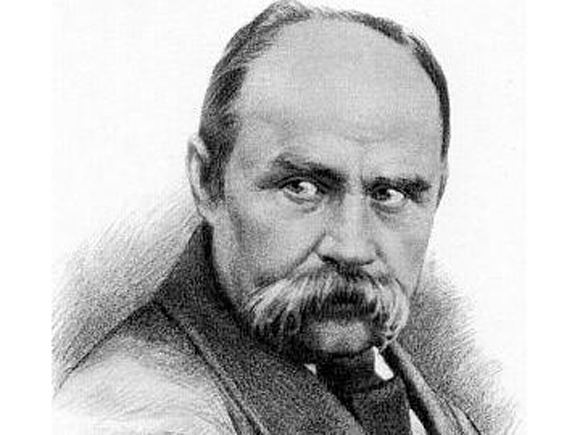
He was a member of the Sts Cyril and Methodius Brotherhood and an academician of the Imperial Academy of Arts. In 1847 Shevchenko was politically convicted for writing in the Ukrainian language, promoting the independence of Ukraine and ridiculing the members of the Russian Imperial House.
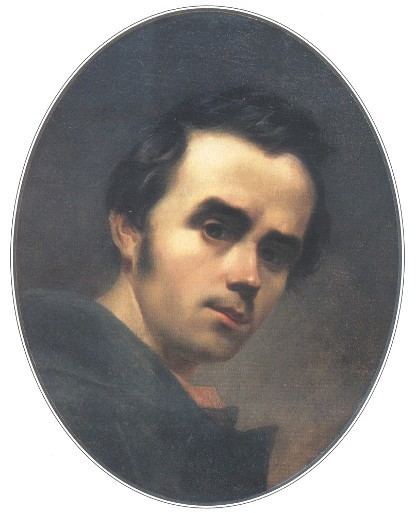
Taras Shevchenko was a father of modern Ukrainian language, poet, writer, artist and patriot.
Childhood and youth
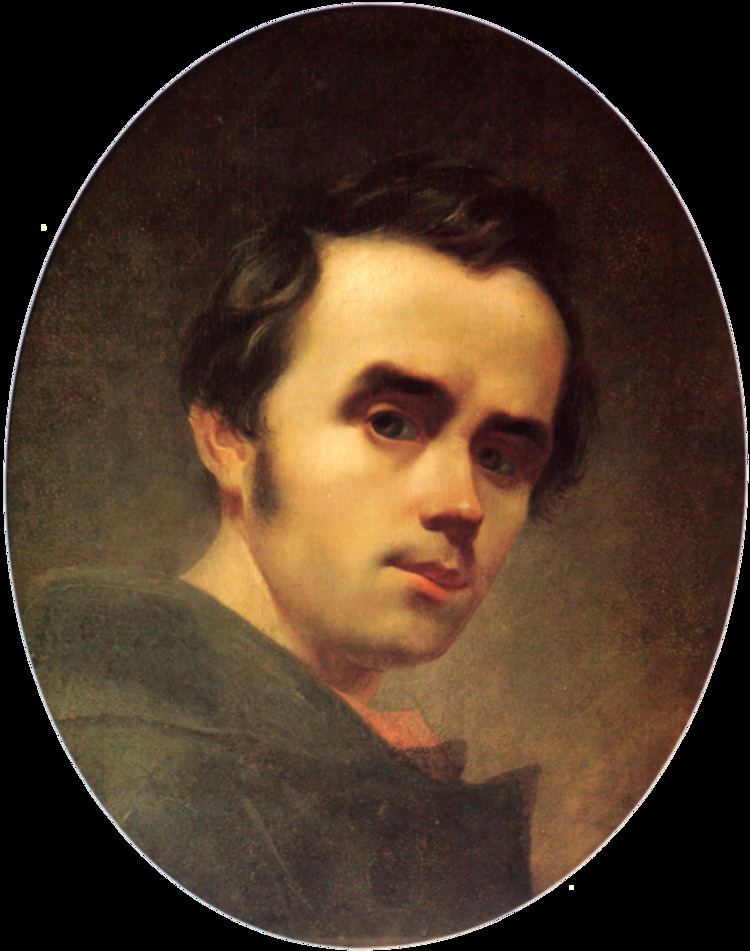
Taras Shevchenko was born on March 9 [O.S. February 25] 1814 in the village of Moryntsi, Zvenyhorodka county, Kiev Governorate, Russian Empire (today Zvenyhorodka Raion, Ukraine). He was the third child after his sister Kateryna and brother Mykyta, in family of serf peasants Hryhoriy Ivanovych Shevchenko (1782? – 1825) and Kateryna Yakymivna Shevchenko (Boiko) (1782? – August 6, 1823), both under Vasily Engelhardt landlord protectorate. According to the family legends, Taras's forefathers were Cossacks who served in the Zaporizhian Host and took part in liberation wars and uprisings of Ukraine in the 17th and 18th centuries. Those uprisings were brutally suppressed in Cherkasy, Poltava, Kiev, Bratslav, and Chernihiv disrupting normal social life for many years. Most of the local population was enslaved and impoverished.
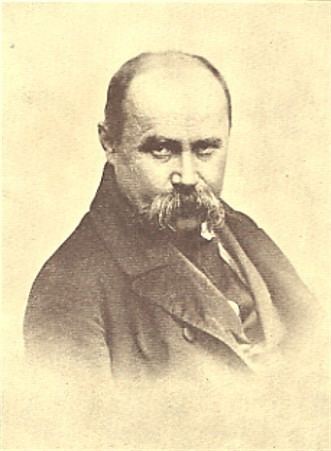
In 1816 Shevchenko family moved back to the village of Kyrylivka (today - Shevchenkove) in Zvenyhorodka county where Taras' father, Hryhoriy Ivanovych, was born. Taras spent his childhood years in that village. On May 24 [O.S. May 12] 1816, Taras' sister Yaryna was born, and on February 7 [O.S. January 26] 1819 - Maria. Once, young Taras went looking for "the iron pillars that hold up the sky" and got lost. Chumaks who met the boy took him with him to Kerelivka. On March 20 [O.S. March 8] 1821 Taras' brother Yosyp was born.
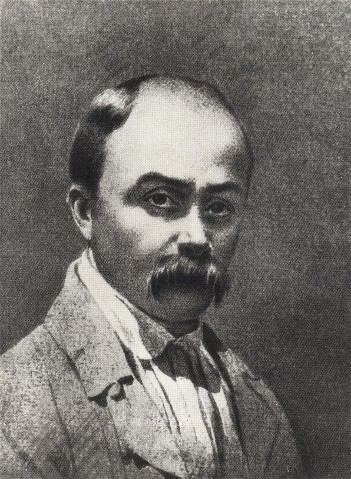
In the fall of 1822 Taras started to take some grammar classes at a local precentor (dyak) Sovhyr. At that time Shevchenko became familiar with Hryhoriy Skovoroda's works. During 1822-1828 Shevchenko painted horses and soldiers.
On February 10 [O.S. January 29] 1823 his older sister and nanny Kateryna married Anton Krasytskyi, a peasant "from Zelena Dibrova". On September 1 [O.S. August 20] 1823 Taras' hard working mother died. A month later on October 19 [O.S. October 7] 1823 his father married a widow Oksana Tereshchenko, a native of Moryntsi village, who already had three children of her own. She cruelly treated her foster children and, in particular, little Taras.
On July 4 [O.S. June 22] 1824 Taras's sister Maria from the second marriage of Hryhoriy Ivanovych was born. In 1824 Taras, along with his father, became a traveling merchant (chumak) and traveled to Zvenyhorodka, Uman, Yelizavetgrad (today Kropyvnytskyi). At the age of eleven Taras became an orphan when, on April 2 [O.S. March 21] 1825, his father died as a serf in corvée. Soon his stepmother along with her children returned to Moryntsi.
Taras went to work for precentor (dyak) Bohorsky who had just arrived from Kiev in 1824. As an apprentice, Taras carried water, heated up a school, served the precentor, read psalms over the dead and continued to study. At that time Shevchenko became familiar with some works of Ukrainian literature. Soon, tired of Bohorsky's long term mistreatment, Shevchenko escaped in search of a painting master in the surrounding villages. For several days he worked for deacon Yefrem in Lysianka, later in other places around in southern part of Kiev Governorate (villages Stebliv and Tarasivka). In 1827 Shevchenko was herding community sheep near his village. He then met Oksana Kovalenko, a childhood friend, whom Shevchenko mentions in his works on multiple occasions. He dedicated the introduction of his poem "Mariana, the Nun" to her.
As a hireling for the Kyrylivka priest Hryhoriy Koshytsia, Taras was visiting Bohuslav where he drove the priest's son to school, while apples and plums - to the market. At the same time he was driving to markets in the towns of Burta and Shpola. In 1828 Shevchenko was hired as a serving boy to a lord's court in Vilshana for permission to study with a local artist. When Taras turned 14, Vasily Engelhardt died and village Kyrylivka became a property of his son, Pavlo Engelhardt. Shevchenko was turned into a court servant of the new landlord at the Vilshana estates. On December 18 [O.S. December 6] 1829 Pavlo Engelgardt caught Shevchenko at night painting a portrait of Cossack Matvii Platov, a hero of the Patriotic War of 1812. He boxed the ears of the boy and ordered him being whipped in the stables with rods. During 1829-1833 Taras copied paintings of Suzdal masters.
For almost two and a half years, from fall of 1828 to start of 1831, Shevchenko stayed with his master in Vilno (Vilnius). Details of the travel are not well known. Perhaps, there he attended lectures by painting professor Jan Rustem at the University of Vilnius. In the same city Shevchenko could also have witnessed the November Uprising of 1830. From those times Shevchenko's painting "Bust of a Woman" survived. It indicates almost professional handling of the pencil.
After moving from Vilno to Saint Petersburg in 1831, Engelgardt took Shevchenko along with him. To benefit from the art works (since it was prestigious to have own "chamber artist"), Engelgardt sent Shevchenko to painter Vasiliy Shiriayev for four-year study. From that point and until 1838 Shevchenko lived in the Khrestovskyi building (today Zahorodnii prospekt, 8) where Shiriayev rented an apartment. In his free time at night, Shevchenko visited the Summer Garden where he portrayed statues. In Saint Petersburg he also started writing his poems.
In 1833 Shevchenko painted a portrait of his landowner Pavlo Engelgardt (National museum of Taras Shechenko).
In his novel "Artist" Shechenko described that during the pre-academical period he painted such works as "Apollo Belvedere", "Fraklete", "Heraclitus", "Architectural barelief", "Mask of Fortune". He participated in painting of the Big Theatre as artist apprentice. He created a composition "Alexander of Macedon shows trust towards his doctor Philip". The drawing was created for a contest of the Imperial Academy of Arts, announced in 1830.
Redemption
In Saint Petersburg Shevchenko met Ukrainian artist Ivan Soshenko, who introduced him to other compatriots such as Yevhen Hrebinka and Vasyl Hryhorovych, and to Russian painter Alexey Venetsianov. Through these men Shevchenko also met famous painter and professor Karl Briullov, who donated his portrait of Russian poet Vasily Zhukovsky as a lottery prize. Its proceeds were used to get Shevchenko's freedom on May 5, 1838.
First successes
In the same year Shevchenko was accepted as a student into the Academy of Arts in the workshop of Karl Briullov. Next year he became a resident student at the Association for the Encouragement of Artists. During annual examinations at the Imperial Academy of Arts, Shevchenko won Silver Medal for landscape painting. In 1840 he again received the Silver Medal, this time for his first oil painting, The Beggar Boy Giving Bread to a Dog.
Shevchenko began writing poetry while still being a serf, and in 1840 his first collection of poetry, Kobzar, was published. According to Ivan Franko, a renowned Ukrainian poet in the generation after Shevchenko, "[Kobzar] was "a new world of poetry. It burst forth like a spring of clear, cold water, and sparkled with a clarity, breadth and elegance of artistic expression not previously known in Ukrainian writing".
In 1841, epic poem Haidamaky was released. In September 1841, Shevchenko was awarded his third Silver Medal for The Gypsy Fortune Teller. Shevchenko also wrote plays. In 1842, he released a part of the tragedy Mykyta Haidai and in 1843 he completed the drama Nazar Stodolia.
While residing in Saint Petersburg, Shevchenko made three trips to Ukraine, in 1843, 1845, and 1846. The difficult conditions Ukrainians had made a profound impact on the poet-painter. Shevchenko visited his siblings, still enserfed, and other relatives. He met with prominent Ukrainian writers and intellectuals Yevhen Hrebinka, Panteleimon Kulish, and Mykhaylo Maksymovych, and was befriended by the princely Repnin family, especially Varvara.
In 1844, distressed by the condition of Ukrainian regions in the Russian Empire, Shevchenko decided to capture some of his homeland's historical ruins and cultural monuments in an album of etchings, which he called Picturesque Ukraine.
Exile
On March 22, 1845, the Council of the Academy of Arts granted Shevchenko the title of a non-classed artist. He again travelled to Ukraine where he met with historian Nikolay Kostomarov and other members of the Brotherhood of Saints Cyril and Methodius, a clandestine society also known as Ukrainian-Slavic society and dedicated to the political liberalization of the Empire and its transformation into a federation-like polity of Slavic nations. Upon the society's suppression by the authorities, Shevchenko's wrote a poem "Dream", that was confiscated from the society's members and became one of the major issues of the scandal.
Shevchenko was arrested along with other members of the society on April 5, 1847. Tsar Nicholas read Shevchenko's poem, "Dream". Vissarion Belinsky wrote in his memoirs that, Nicholas I, knowing Ukrainian very well, laughed and chuckled whilst reading the section about himself, but his mood quickly turned to bitter hatred when he read about his wife. Shevchenko had mocked her frumpy appearance and facial tics, which she had developed fearing the Decembrist Uprising and its plans to kill her family. After reading this section the Tsar indignantly stated "I suppose he had reasons not to be on terms with me, but what has she done to deserve this?" In the official report of Orlov Shevchenko was accused in using "Little-Russian language" (archaic Russian name for Ukrainian language) of outrageous content instead of being grateful to be redeemed out of serfdom. In the report Orlov claimed that Shevchenko was expressing a cry over alleged enslavement and disaster of Ukraine, glorified the Hetman Administration (Cossack Hetmanate) and Cossack liberties and "with incredible audacity poured slander and bile on persons of Imperial House".
While under investigation, Shevchenko was imprisoned in Saint Petersburg in casemates of the 3rd Department of Imperial Chancellery on Panteleimonovskaya Street (today Pestelia str., 9). After being convicted, he was exiled as a private to the Russian military garrison in Orenburg at Orsk, near the Ural Mountains. Tsar Nicholas I, confirming his sentence, added to it, "Under the strictest surveillance, without the right to write or paint."
He was subsequently sent on a forced march from Saint Petersburg to Orenburg where, at the suggestion of fellow serviceman Bronisław Zaleski, General Perovsky assigned him to Karl Ernst von Baer, a Baltic-German naturalist. Von Baer was a rising star in the Academy of Sciences in Saint Petersburg and was becoming increasingly influential in the exploration of the new Russian territories, specializing in lakes and fisheries. He had been selected to undertake the first scientific expedition of the Aral Sea on the ship "Konstantin", under the command of Lieutenant Butakov. Although officially a common sailor, Shevchenko was tasked to sketch various landscapes around the coast of the Aral Sea, including the local Kazakhs nomads, and was effectively treated as an equal by the other members of the expedition. After 18-month voyage (1848–49) Shevchenko returned with his album of drawings and paintings to General Perovsky at Orenburg, who was impressed with his work and sent a positive report to Saint Petersburg hoping to obtain some amelioration in Shevchenko’s punishment. However Perovsky was reprimanded and Shevchenko’s punishment was increased to imprisonment. He was then sent to one of the worst penal settlements, the remote fortress of Novopetrovsk in the mouth of the Syr Darya, where he spent six terrible years of mental and physical torment.
In 1857 Shevchenko finally returned from exile after receiving amnesty, though he was not permitted to return to St. Petersburg and was ordered to Nizhniy Novgorod. In May 1859, Shevchenko got permission to return to Ukraine. He intended to buy a plot of land close to the village of Pekariv. In July, he was again arrested on a charge of blasphemy, but then released and ordered to return to St. Petersburg.
Death
Taras Shevchenko spent the last years of his life working on new poetry, paintings, and engravings, as well as editing his older works, however after difficult years in exile his illnesses took too much. Shevchenko died in Saint Petersburg on March 10, 1861, the day after his 47th birthday.
He was first buried at the Smolensk Cemetery in Saint Petersburg. However, fulfilling Shevchenko's wish, expressed in his poem "Testament" ("Zapovit"), to be buried in Ukraine, his friends arranged the transfer of his remains by train to Moscow and then by horse-drawn wagon to his homeland. Shevchenko was re-buried on May 8 on the Chernecha hora (Monk's Hill; today Taras Hill) near the Dnipro River and Kaniv. A tall mound was erected over his grave, now a memorial part of the Kaniv Museum-Preserve.
Dogged by terrible misfortune in love and life, the poet died seven days before the Emancipation of Serfs was announced. His works and life are revered by Ukrainians throughout the world and his impact on Ukrainian literature is immense.
Family
Shevchenko never married. He had six siblings and at least three step-siblings, of whom only Stepan Tereshchenko (1820?–unknown) is known. Some sources connect him to the Tereshchenko family of Ukrainian industrialists.
- Kateryna Hryhorivna Krasytska (Shevchenko) (1806–1850) married Anton Hryhorovych Krasytsky (1794–1848)
- Yakym Krasytsky
- Maksym Krasytsky (unknown–1910)
- Stepan Krasytsky
- Fedora Krasytska (1824?–unknown), known painter
- Mykyta Hryhorovych Shevchenko (1811–1870?)
- Iryna Kovtun (Shevchenko)
- Prokop Shevchenko
- Petro Shevchenko (1847–1944?)
- Maria Hryhorivna Shevchenko (1814?–unknown) (His twin sister)
- Yaryna Hryhorivna Boiko (Shevchenko) (1816–1865) married Fedir Kondratievych Boiko (1811–1850)
- Maryna Boiko
- Ustyna Boiko (1836–unknown)
- Illarion Boiko (1840–unknown)
- Lohvyn Boiko (1842–unknown)
- Ivan Boiko (1845–unknown)
- Lavrentiy Boiko (1847–unknown)
- Maria Hryhorivna Shevchenko (1819–1846)
- Yosyp Hryhorovych Shevchenko (1821–1878) married Matrona Hryhorivna Shevchenko (1820?–unknown), far relative
- Andriy Shevchenko
- Ivan Shevchenko
- Trokhym Shevchenko (September 20, 1843–unknown)
Impact
Taras Shevchenko's writings formed the foundation for the modern Ukrainian literature to a degree that he is also considered the founder of the modern written Ukrainian language (although Ivan Kotlyarevsky pioneered the literary work in what was close to the modern Ukrainian in the end of the 18th century.) Shevchenko's poetry contributed greatly to the growth of Ukrainian national consciousness, and his influence on various facets of Ukrainian intellectual, literary, and national life is still felt to this day. Influenced by Romanticism, Shevchenko managed to find his own manner of poetic expression that encompassed themes and ideas germane to Ukraine and his personal vision of its past and future.
In view of his literary importance, the impact of his artistic work is often missed, although his contemporaries valued his artistic work no less, or perhaps even more, than his literary work. A great number of his pictures, drawings and etchings preserved to this day testify to his unique artistic talent. He also experimented with photography and it is little known that Shevchenko may be considered to have pioneered the art of etching in the Russian Empire (in 1860 he was awarded the title of Academician in the Imperial Academy of Arts specifically for his achievements in etching.)
His influence on Ukrainian culture has been so immense, that even during Soviet times, the official position was to downplay strong Ukrainian nationalism expressed in his poetry, suppressing any mention of it, and to put an emphasis on the social and anti-Tsarist aspects of his legacy, the Class struggle within the Russian Empire. Shevchenko, who himself was born a serf and suffered tremendously for his political views in opposition to the established order of the Empire, was presented in the Soviet times as an internationalist who stood up in general for the plight of the poor classes exploited by the reactionary political regime rather than the vocal proponent of the Ukrainian national idea.
This view is significantly revised in modern independent Ukraine, where he is now viewed as almost an iconic figure with unmatched significance for the Ukrainian nation, a view that has been mostly shared all along by the Ukrainian diaspora that has always revered Shevchenko.
He inspired some of the protestors during the Euromaidan.
Contribution to Russian literature
Some of Shevchenko's prose (a novel, diary, plays "Nazar Stodolya" and "Nikita Gayday", many letters), as well as some of his poems were written in Russian, thus, some researchers consider Shevchenko as a notable Russian writer.
Monuments and memorials
There are many monuments to Shevchenko throughout Ukraine, most notably at his memorial in Kaniv and in the center of Kiev, just across from the Kiev University that bears his name. The Kiev Metro station, Tarasa Shevchenka, is also dedicated to Shevchenko. Among other notable monuments to the poet located throughout Ukraine are the ones in Kharkiv (in front of the Shevchenko Park. Kharkiv|Shevchenko Park), Lviv, Luhansk and many others.
After Ukraine gained its independence in the wake of the 1991 Soviet Collapse, some Ukrainian cities replaced their statues of Lenin with statues of Taras Shevchenko and in some locations that lacked streets named to him, local authorities renamed the streets or squares to Shevchenko. There is also a bilingual Taras Sevchenko high school in Sighetu Marmatiei, Romania.
Outside of Ukraine and the former USSR, monuments to Shevchenko have been put up in many countries, usually under the initiative of local Ukrainian diasporas. There are several memorial societies and monuments to him throughout Canada and the United States, most notably the monument in Washington, D.C., near Dupont Circle. The granite monument was carved by Vincent Illuzzi of Barre, Vermont. There is also a monument in Soyuzivka in New York State, Tipperary Hill in Syracuse, New York, a park is named after him in Elmira Heights, N.Y. and a street is named after him in New York City's East Village. A section of Connecticut Route 9 that goes through New Britain is also named after Shevchenko. A monument to Shevchenko was put up in Zagreb, Croatia on May 21, 2015.
There is also a statue of Taras Shevchenko in the central park near the St. Krikor Lusavorich Cathedral in Yerevan, Armenia.
Example of poetry: "Testament" (Zapovit)
Shevchenko's "Testament", (Zapovit, 1845), has been translated into more than 60 languages and set to music in the 1870s by H. Hladky. The poem enjoys a status second only to Ukraine’s national anthem.
Artwork
835 works survived into modern times in original form and partly in prints engraved on metal and wood by Russian and other foreign engravers, while some works survived as copies done by painters while Shevchenko still lived. There is data on over 270 more works which were lost and have not been found yet. Painted and engraved works at the time of completion are dated 1830-1861 and are territorially related to Ukraine, Russia and Kazakhstan. The genres are - portraits, compositions on mythological, historical and household themes, architectural landscapes and scenery. The techniques used for that were oil painting on canvas, watercolor, sepia, inking, lead pencil, as well as etching on separate sheets of white, colored and tinted paper of different sizes and in five albums. A significant part of Shevchenko's artistic heritage consists of completed paintings, however there are also sketches, etudes and outlines which are no less valuable for understanding Shevchenko's methods and artistic path. Of all Shevchenko's paintings only a small part has any authorial signatures or inscriptions and even smaller part has dates.
